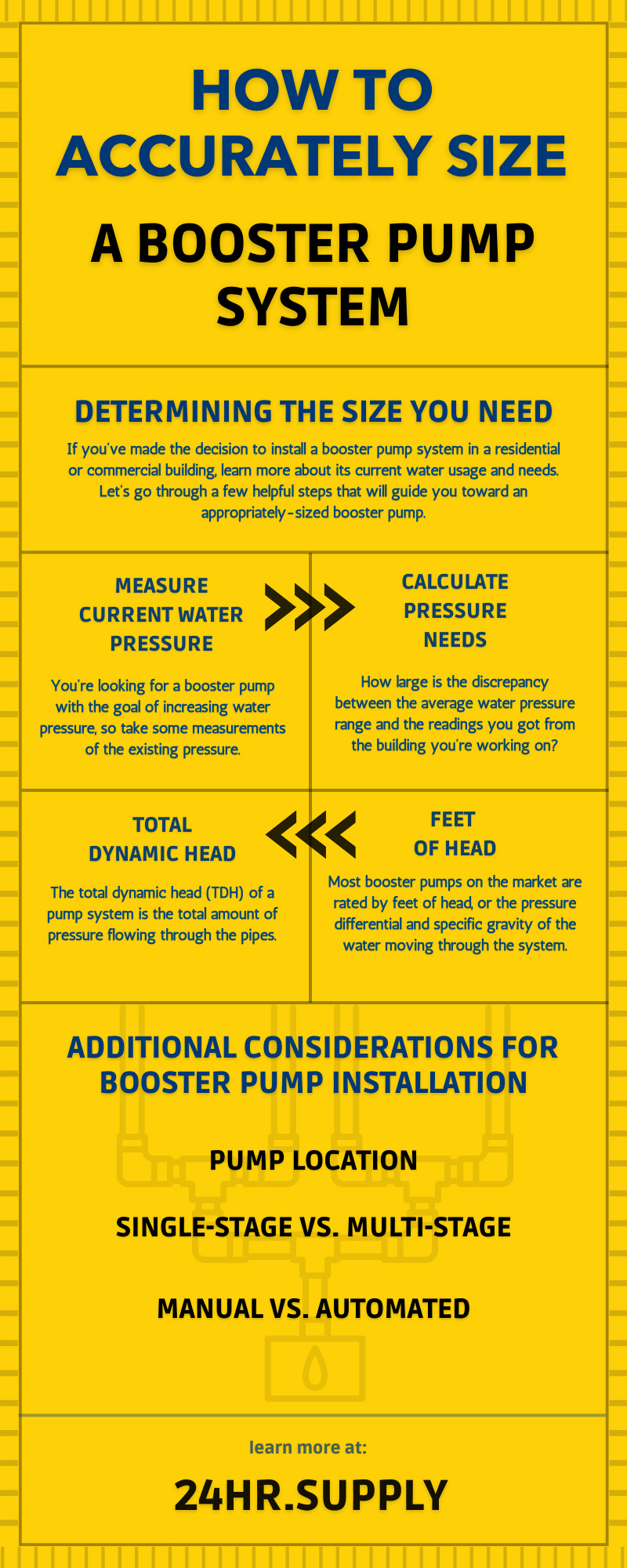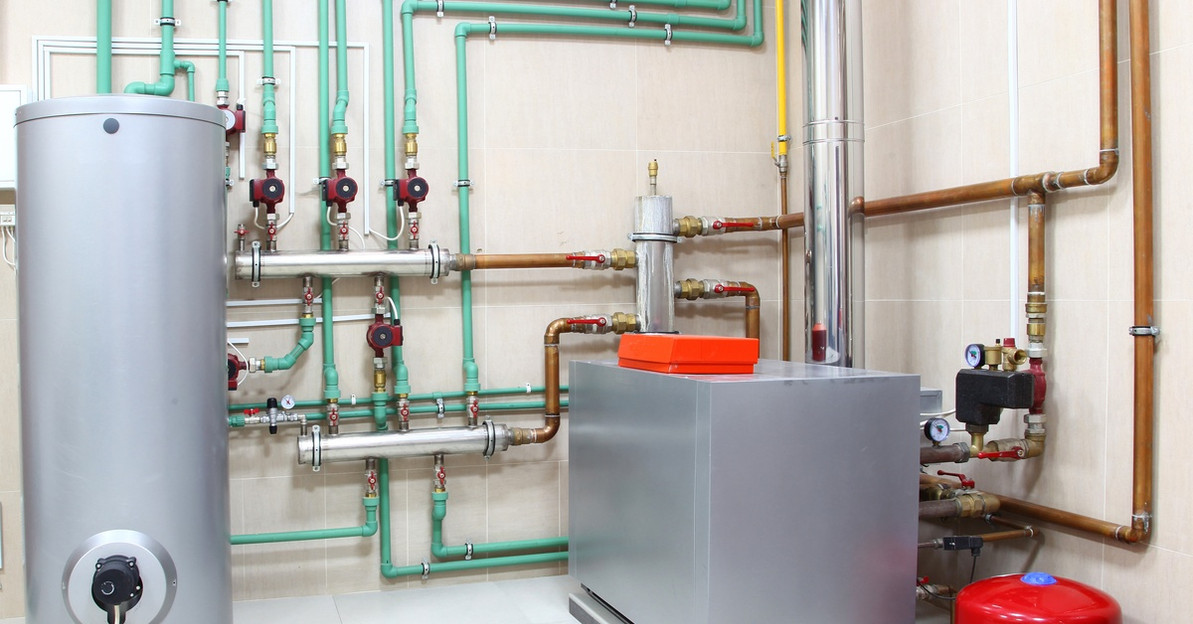How To Accurately Size a Booster Pump System
Whether you’re working on the top floor of a high-rise building or on a single-family home with unreliable water pressure, a booster pump can increase the place’s comfort and functionality. Many plumbing systems rely at least partially on gravity to deliver water to the various fixtures and appliances in the building. But when gravity doesn’t work in your favor, a booster pump does just what the name implies—it boosts water pressure by pumping water against the flow of gravity.
To start the process of improving water pressure, learn how to accurately size a booster pump system for a building’s needs. Matching your new booster pump to the existing system’s unique plumbing specifications will make installation easier and faster.
What Does a Booster Pump Do?
When properly sized and installed, a booster pump acts as an intermediary force between a water source and the various fixtures and appliances in a house. In living spaces where water needs to travel a long distance, especially uphill, a booster pump system helps maintain consistent and high water pressure. Most booster pump systems are centrifugal in nature, moving water through one or more impellers to boost its pressure before pushing it along.
Who Needs a Booster Pump?
Booster pump systems are highly beneficial for elevated living spaces like high-rise apartment buildings and homes in hilly areas. If any of the following conditions apply to the system you’re working on, it may be an ideal candidate for a booster pump.
- Units on higher floors of apartment buildings
- Buildings that are uphill from their water source
- Homes in growing and expanding neighborhoods
- Buildings with inconsistent or insufficient water pressure
Determining the Size You Need
If you’ve made the decision to install a booster pump system in a residential or commercial building, learn more about its current water usage and needs. Let’s go through a few helpful steps that will guide you toward an appropriately-sized booster pump.
Measure Current Water Pressure
You’re looking for a booster pump with the goal of increasing water pressure, so take some measurements of the existing pressure. You’ll need a one-gallon bucket or container and a timer or wristwatch.
Locate the building’s outermost faucet or spigot at the entry point of its water supply. Place the bucket under the faucet and turn the water on as you time how long it takes to fill completely. Divide that time (in seconds) by 60 to determine the system’s flow rate in gallons per minute.
On average, municipal water supplies deliver water at a flow rate between 2.5 and 6 gallons per minute, with water pressure between 65 and 85 pounds per square inch (PSI). If your calculations are well below this range, a booster pump will bring the water pressure up to a normal level.
Calculate Pressure Needs
How large is the discrepancy between the average water pressure range and the readings you got from the building you’re working on? If the current water pressure hovers around 45 PSI, and you’d like to boost it to 65 PSI, you’ll need a booster pump with at least a 20 PSI capacity.
Keep those calculations on hand as you shop for booster pump systems, so you can choose one that fits in seamlessly with the existing system.
Total Dynamic Head
The total dynamic head (TDH) of a pump system is the total amount of pressure flowing through the pipes. This calculation is especially important if water needs to travel uphill—or vertically upward—to reach its destination.
You’ll need to determine two values to find the TDH: the vertical rise, or the distance the water travels, and the friction loss of the pipe the water travels through. There are several convenient friction loss calculators available for free online—just input the dimensions of the pipe and the system’s liquid flow rate. Once you have a value for friction loss, add it to your vertical rise to get your total dynamic head calculation.
Feet of Head
Most booster pumps on the market are rated by feet of head, or the pressure differential and specific gravity of the water moving through the system. Do you need to convert your PSI readings to feet of head, or vice versa? Use these formulas:
- Pressure in PSI x 2.31 = feet of head
- Pressure in feet of head x 0.433 = PSI
Additional Considerations for Booster Pump Installation
Once you’ve done the necessary calculations to size the new booster pump, think about other potential logistical concerns.
Pump Location
Where will you be installing the booster pump system? Choose an area that’s easy to access in case repairs are necessary in the future. If the building gets its water from a storage tank, for example, install the booster pump right above the source. This way, you won’t need to install excessive amounts of suction pipe in between the source and the pump.
Single-Stage vs. Multi-Stage
As you shop for booster pump equipment, whether online or in person, you’ll likely see pumps in both single-stage and multi-stage configurations.
A single-stage booster pump system attaches directly to the water supply’s main pipe and draws water into the building in one stage. Meanwhile, a multi-stage system has multiple impellers that use centrifugal force to pull water where it needs to go. Multi-stage booster pumps are especially helpful in agricultural applications like crop irrigation.
Manual vs. Automated
A manual booster pump requires increasing water pressure the old-fashioned way by flipping a switch or valve. Meanwhile, an automated booster pump system turns on by itself when internal sensors indicate a need for higher water pressure.
If a building you’re working on has consistent issues with low water pressure, the right booster pump system can increase the functionality of its fixtures. To get the most out of that boost in pressure, you will need to accurately size the pump for the building’s unique water pressure and flow rate needs. Use this guide from 24hr Supply to make the necessary calculations and shop for booster pump components with confidence!

Recent Posts
-
Must-Have Tools for Tackling Plumbing Clogs
Clogs are one of the most common issues professional plumbers will encounter on the job. These clogs …Dec 29th 2025 -
A Guide to Implementing Indirect Water Heating With Boilers
Choosing the right water heating method for your home or business significantly impacts energy effic …Dec 9th 2025 -
How Tankless Water Heaters Can Benefit Commercial Kitchens
A commercial kitchen operates at a fast pace and maintains very high performance standards. Every pi …Dec 3rd 2025





